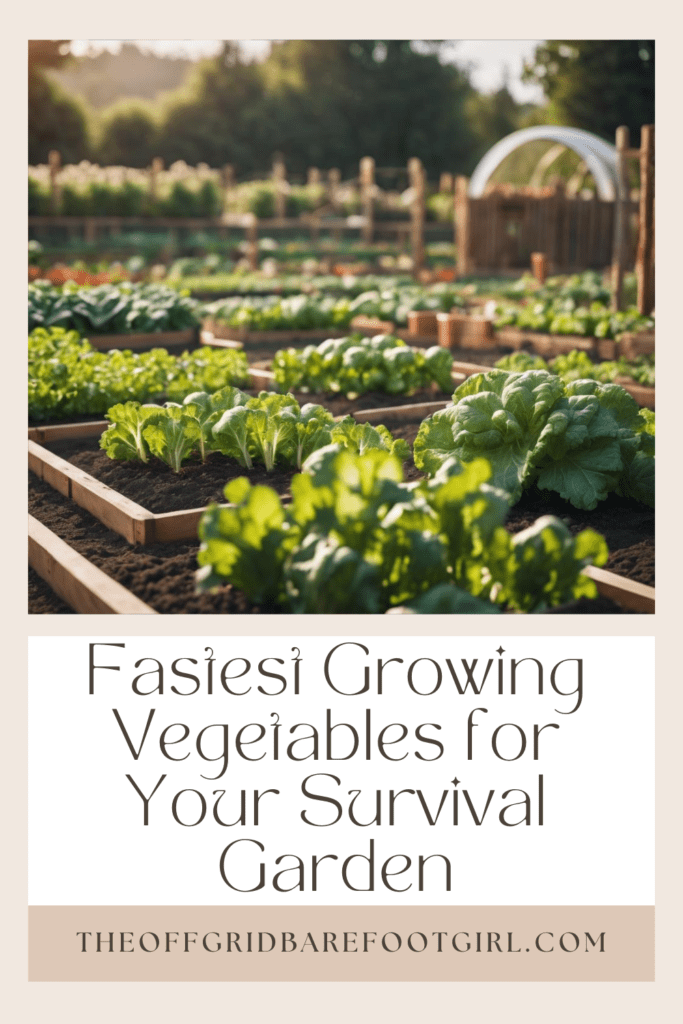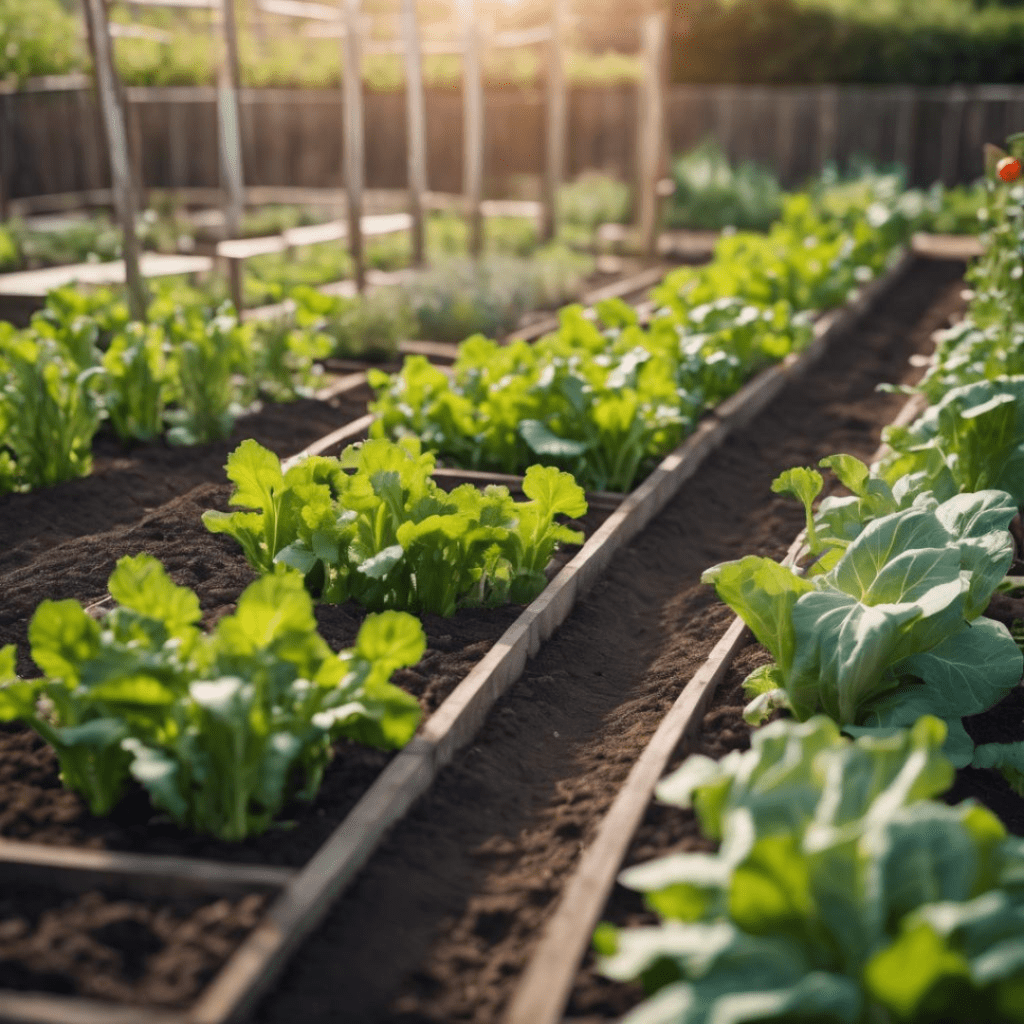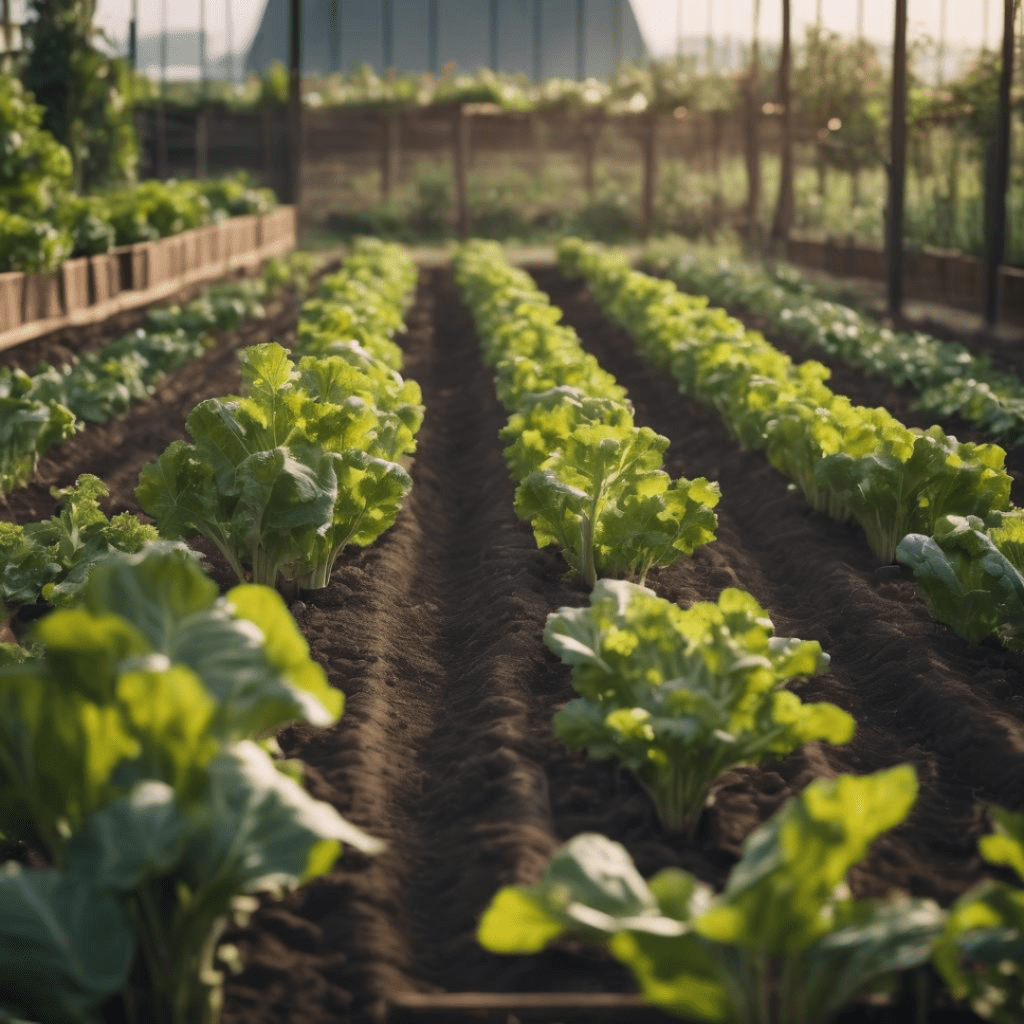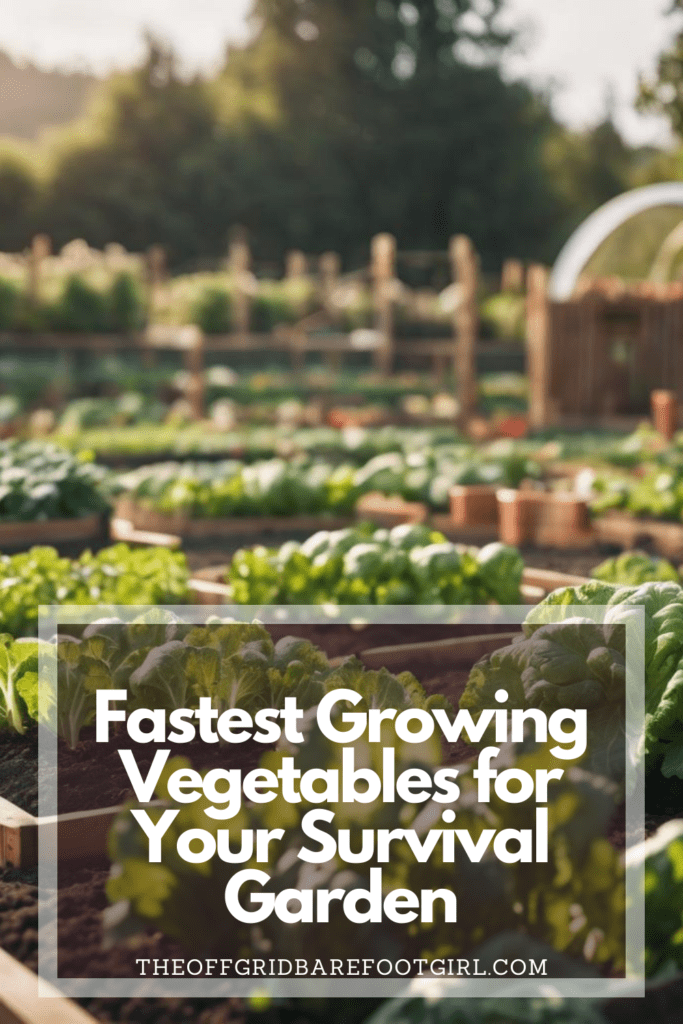Fastest growing vegetables.
When it comes to survival gardening, time is of the essence. In a world where self-sufficiency and sustainable food sources are becoming increasingly important, fast-growing vegetables play a vital role. These vegetables offer the advantage of quick maturation, providing you with a bountiful harvest in a shorter period. Whether you are preparing for an emergency situation or simply looking to maximize the productivity of your garden, incorporating fast-growing vegetables is a smart choice. In this article, I will explore the significance of fast-growing vegetables in a survival garden, discuss the criteria for selecting the right varieties, and provide valuable tips and techniques for cultivating, maximizing yield, and overcoming challenges. Get ready to discover the fastest-growing vegetables that can transform your survival garden into a thriving and sustainable food source.
This is a pinnable post. Tap or hover over any image in this post to pin to your Pinterest Boards.

Introduction to Fast-Growing Vegetables: Enhancing Your Survival Garden
Understanding the Importance of Fast-Growing Vegetables In a Survival Garden
Ah, the survival garden. It’s like a secret hideaway for plant enthusiasts with a touch of doomsday prepper. But let’s face it, in these uncertain times, having a survival garden is a smart move. And if you want to take it up a notch, you need to know about fast-growing vegetables.
Fast-growing vegetables are like the superheroes of the garden world. They swoop in, save the day, and provide you with a bountiful harvest in record time. These speedy veggies are essential for any survival garden because they can be your lifeline when you need fresh, nutritious food on your plate ASAP!
The Role of Fast-Growing Vegetables In Providing a Sustainable Food Source
When disaster strikes or when you just want to be more self-sufficient, a survival garden becomes your go-to food source. But here’s the thing: you don’t want to wait ages for your vegetables to grow. You need food now!
That’s where these vegetables come in handy. They sprout, grow, and produce deliciousness in no time. With these veggies in your garden, you can ensure a sustainable food source that keeps you fed and happy!
Importance of Fast-Growing Vegetables in a Survival Garden

Why Fast-Growing Vegetables are Crucial for Survival Gardeners
As a survival gardener, time is of the essence. You want to grow food quickly and efficiently so that you’re never caught empty-handed (or hungry). Fast-growing vegetables allow you to do just that.
These vegetables are like the Usain Bolt of the plant world. They sprint from seed to harvest, beating their slower counterparts by weeks or even months. When your survival depends on fresh produce, every day counts. These vegetables can mean the difference between a satisfying meal and staring longingly at unripe tomatoes.
The Benefits of Quick Maturing Crops for Food Security
Food security is not something to take lightly, especially in uncertain times. Quick-maturing crops provided by fast-growing vegetables are a game-changer when it comes to securing your food supply.
Imagine this: you’re out of canned beans, supermarket shelves are bare, and your stomach is growling. But fear not, because your survival garden has got your back! With the right selection of these vegetables, you can have a continuous supply of fresh produce, ensuring that you and your loved ones never go hungry.
Criteria for Selecting Fast-Growing Vegetables for Your Survival Garden
Factors to Consider When Choosing Fast-Growing Vegetable Varieties
Now that you’re convinced of the importance of these vegetables, it’s time to choose the right ones for your survival garden. But how do you decide which varieties to go for?
When selecting these vegetables, keep in mind factors like your climate, available space, and personal preferences. Some vegetables thrive in cool, northern climates, while others prefer the heat of the south. Consider your local conditions and choose varieties that are best suited for your specific region.
Adapting Vegetable Selection to Your Climate and Growing Conditions
Remember, not all vegetables are created equal when it comes to speediness. Some may take a few weeks to mature, while others will be ready for your plate in a matter of days. So, adapt your vegetable selection to match your climate and growing conditions.
If you live in a colder region or have a short growing season, look for vegetables that can handle the chill and mature quickly. On the other hand, if you’re in a warmer area, seek out heat-tolerant varieties that won’t be sluggish in the summer heat. With a little planning, you can maximize your survival garden’s potential and ensure a thriving crop in no time!
Top 5 Fastest-Growing Vegetables to Consider for Your Survival Garden
Overview of the Fastest-Growing Vegetable Options for Survival Gardens
Now, let’s get to the exciting part – the fastest-growing vegetables you’ll want to consider for your survival garden. These Speedy Gonzales of the vegetable world will amaze you with their growth rate and ability to deliver fresh produce to your plate in a flash.
Detailed Profiles of the Top 5 Fast-Growing Vegetables
1. Radishes: These little root veggies are like the cheetahs of the garden. They can go from seed to harvest in just about a month. Plus, they come in various colors and flavors, making them a fun addition to any salad or stir-fry. Talk about instant gratification!
2. Salad Greens: Lettuce, spinach, and other leafy greens are some of the quickest vegetables to grow. In as little as three weeks, you can start snipping off fresh leaves for a crisp, flavorful salad. Who needs store-bought greens when you have your own personal salad bar in the backyard?
3. Green Beans: With the right variety, green beans can reach maturity in just 50 days. These legumes are not only fast-growing, but also packed with vitamins and minerals. Whether you prefer them steamed, sautéed, or in a hearty stew, you’ll have a bountiful harvest in no time.
4. Cucumbers: These refreshing summer treats can be on your table in as little as 50 days. They love warm weather and will reward you with crunchy goodness for your salads, pickles, or even a refreshing cucumber-infused drink.
5. Baby Carrots: Don’t let their small size fool you; baby carrots are quick growers. In about 30 days, you can start pulling these sweet, tender delights from the ground. Perfect for snacking, roasting, or adding a pop of color to your garden’s edible landscape.
With these vegetables in your survival garden, you’ll be well on your way to reaping the benefits of fresh produce without the long wait. So, get planting and enjoy the speediness and deliciousness these veggies bring to your table.
Cultivation Techniques and Tips for Fast-Growing Vegetables
Preparing the Soil for Optimal Growth and Yield
To ensure your fast-growing vegetables thrive, start by preparing the soil. Clear any weeds or debris and loosen the soil with a garden fork or tiller. Incorporate organic matter like compost or well-rotted manure to improve soil fertility and drainage. Fast-growing vegetables benefit from nutrient-rich soil, so consider using a balanced organic fertilizer before planting.
Planting and Spacing Recommendations for Fast-Growing Vegetables
When it comes to planting fast-growing vegetables, spacing is crucial. Follow the guidelines on the seed packet or plant label to determine the recommended distance between plants. Crowding can lead to poor airflow and an increased risk of diseases. Additionally, consider succession planting to extend your harvest. Sow seeds or transplant seedlings every few weeks for a continuous supply.
Key Care Practices to Ensure Rapid and Healthy Growth
To encourage rapid and healthy growth, water your fast-growing vegetables consistently. Aim to keep the soil evenly moist without overwatering. Mulching around plants can help retain moisture and suppress weeds. Regularly inspect your plants for signs of pests or diseases and take appropriate action immediately. Providing support, such as trellises for climbing plants, will help them flourish and maximize space.
Maximizing Yield and Harvesting Fast-Growing Vegetables in Your Survival Garden
Strategies for Maximizing the Productivity of Fast-Growing Vegetables
To maximize your yield, try intercropping or companion planting. Pairing fast-growing vegetables with different growth habits can optimize space and resources. Additionally, consider using trellises or vertical gardening techniques to make the most of limited space. Regularly harvest mature vegetables to encourage further production and prevent overcrowding.
I wrote an in-depth article on companion planting with a full vegetable chart that can help you determine how to place your plants in your garden.
How to Do Companion Planting: Friends or Foes?
Grow a Survival Garden
I have full posts about how to grow a survival garden that can help you get started in growing a survival garden of your own!
- Why I Built A Survival Garden in My Backyard
- Build Your Survival Garden with an All-In-One Homestead Seed Bank!
Harvesting Techniques and Timing for Different Fast-Growing Crops
Fast-growing vegetables have different harvesting requirements. Leafy greens, like lettuce or spinach, can be harvested by picking individual leaves as needed. Root vegetables, such as radishes or carrots, are typically ready for harvest when the tops appear mature. For crops like zucchini or cucumbers, frequent harvesting of young and tender produce is ideal to encourage continuous production.
Common Challenges and Solutions for Growing Fastest-Growing Vegetables in a Survival Garden

Identifying and Overcoming Common Issues Faced with Fast-Growing Vegetables
Fast-growing vegetables can face challenges like nutrient deficiencies, pests, and diseases. Keep an eye out for yellowing leaves, stunted growth, or unusual discoloration, which may indicate nutrient imbalances. Regularly inspect plants for signs of pests, such as holes or chewed leaves, and take appropriate measures, like handpicking or using organic pest control methods. Promptly address any diseases by removing infected plants or applying suitable treatments.
To help you grow organically with natural pest control measures, I have written special articles on how to use marigolds and ladybugs for effective pest control in your garden.
- How to Grow Marigolds As Pest Control In Your Vegetable Garden
- How to Release Ladybugs In Your Garden for Organic Pest Control
- The Best Tips for Organic Gardening
Effective Pest and Disease Management for Rapid-Growing Crops
Implementing preventative measures is crucial for managing pests and diseases. Encourage beneficial insects, like ladybugs or lacewings, to control pests naturally. Practice crop rotation to reduce the risk of disease buildup in the soil. Applying organic pest and disease controls, such as neem oil or insecticidal soap, can help manage infestations. Regularly monitor your plants and address issues promptly to prevent further damage.
Conclusion: Creating a Sustainable and Productive Survival Garden with Fast-Growing Vegetables
Incorporating fast-growing vegetables into your survival garden is a smart and practical choice. By following proper cultivation techniques, ensuring optimal care, and addressing common challenges, you can create a sustainable and productive garden. Not only will these vegetables provide you with a quick supply of nutritious food, but they will also add variety and flavor to your meals. So, get ready to enjoy the rewards of your efforts while embracing the delicious taste of homegrown, fast-growing vegetables!
Incorporating fast-growing vegetables into your survival garden is an effective way to ensure a sustainable and productive food source. By understanding the importance of these vegetables and carefully selecting the right varieties, you can enjoy a rapid and abundant harvest, even in challenging conditions. With proper cultivation techniques, timely care, and strategic harvesting, you can maximize the yield of your fast-growing vegetables. Remember, challenges may arise, but with perseverance and the right solutions, you can overcome them. By embracing fast-growing vegetables, you are taking a significant step towards self-sufficiency and enhancing your survival garden. Start planting these quick-maturing crops and reap the rewards of a thriving and resilient garden.

Frequently Asked Questions
1. Why are fast-growing vegetables important for a survival garden?
Fast-growing vegetables are essential for a survival garden because they offer a quicker turnaround time from planting to harvest. In emergency situations or when relying on your garden for sustenance, fast-growing vegetables provide a vital source of fresh produce in a shorter period. They help ensure a more consistent and reliable food supply, especially in challenging circumstances.
2. How do I select the right fast-growing vegetable varieties for my survival garden?
When choosing fast-growing vegetable varieties for your survival garden, consider factors such as your climate, available space, and personal preferences. Look for varieties that are specifically labeled as fast-maturing or early-maturing. Additionally, consider the nutritional value, storage life, and versatility of the vegetables to meet your long-term survival needs.
3. What cultivation techniques can I use to optimize the growth of fast-growing vegetables?
To optimize the growth of fast-growing vegetables, start by preparing the soil with organic matter and ensuring proper drainage. Provide adequate sunlight, water, and nutrients based on the specific requirements of each vegetable. Additionally, practicing proper spacing, regular weeding, and mulching can help promote healthy and vigorous growth. Monitoring for pests and diseases and taking appropriate preventive measures is also crucial.
4. Are there any common challenges when growing fast-growing vegetables in a survival garden?
While fast-growing vegetables offer numerous benefits, they can also present challenges. Some common challenges include pest infestations, diseases, inadequate watering or overwatering, poor soil quality, and unpredictable weather conditions. However, with proper planning, proactive care, and implementation of preventive strategies, these challenges can be managed effectively to ensure a successful harvest.
Summary
I hope I have inspired you to explore the fastest vegetables to grow with these tips and products.
If you were encouraged by this post, I invite you to check out my FREE Printables Page for fun free printables, planners, and charts.
ENTER MY FREE Printables Page HERE
Here are some more of my gardening inspiration posts to check out!
How to Grow Marigolds As Pest Control In Your Vegetable Garden
Must-Have Tools for a Successful Balcony Vegetable Garden
How to Effectively Combat Powdery Mildew in Your Garden
The Best Tips for Organic Gardening
How to Release Ladybugs In Your Garden for Organic Pest Control
The Best Garden Snail Control Strategies
The Best Spring Vegetables to Grow in Your Garden
Seed Starter Mix: How To Make Your Organic Seed Starter Mix At Home
How to Grow a Productive Canning Garden
How to Plant and Grow a Salsa Garden
Easiest Heirloom Vegetable Seeds to Grow Now
How to Use the Hand Twist Claw Tiller: Tackling Tough Soil
Planning Your Garden: How to Plan a Vegetable Garden: Expert Green Thumb Tips!
Winterizing the Garden: How to Winterize Your Vegetable Garden: Step-by-Step Checklist
Mulching the Garden: How to Make Leaf Litter Mulch
Grow a Pumpkin Patch: How to Grow a Pumpkin Patch in Your Backyard
How to Win a Giant Pumpkin Contest
How to Grow a Fall Garden: 9 Best Fall Crops
Clever Ways to Incorporate Indoor Composting into Your Home
How to Start Composting for the Garden: A Step-by-Step Guide
The Ultimate Guide to Composting in Your Suburban Backyard
Why I Built A Survival Garden in My Backyard
How to Grow A Foodscape Garden From Scratch
16 Best Medicinal Herbs to Grow in Your Garden Now
Blessings,
The Off Grid Barefoot Girl




